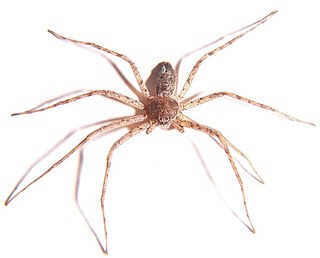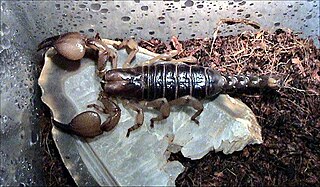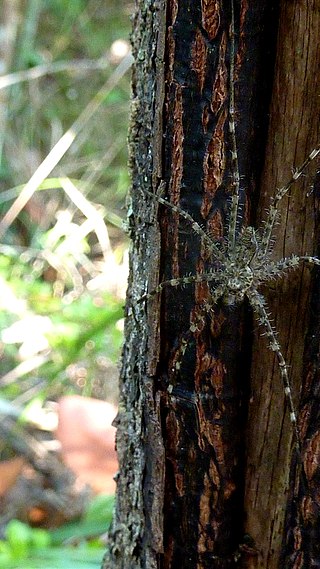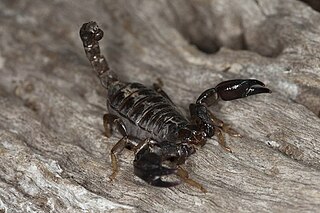
The Thomisidae are a family of spiders, including about 170 genera and over 2,100 species. The common name crab spider is often linked to species in this family, but is also applied loosely to many other families of spiders. Many members of this family are also known as flower spiders or flower crab spiders.

The sac spiders of the family Clubionidae have a very confusing taxonomic history. Once, this family was a large catch-all taxon for a disparate collection of spiders, similar only in that they had eight eyes arranged in two rows and conical anterior spinnerets that touched, and were wandering predators that built silken retreats, or sacs, usually on plant terminals, between leaves, under bark, or under rocks. These are now recognized to include several families, some of which are more closely related to the three-clawed spiders, like lynx and wolf spiders, than to Clubionidae and related families.

Philodromidae, also known as philodromid crab spiders and running crab spiders, is a family of araneomorph spiders first described by Tord Tamerlan Teodor Thorell in 1870. It contains over 500 species in thirty genera.

Opistophthalmus is a genus of scorpions known commonly as burrowing scorpions, tricolored scorpions, serkets, or hissing scorpions. They are found predominantly in southern Africa. They are known for making deep and elaborate burrows.
Ceglusa is a monotypic genus of Burmese jumping spiders containing the single species, Ceglusa polita. It was first described by Tamerlan Thorell in 1895, and is only found in Myanmar. It was described from a single 5 millimetres (0.20 in) long female, and no drawings exist. and no studies were published on it since. Its taxonomic relationships within the family are unknown.

Trechaleidae (tre-kah-LEE-ih-dee) is a family of araneomorph spiders first described by Eugène Simon in 1890. It includes about 140 described species in 16 genera. They all live in Central and South America except for Shinobius orientalis, which is endemic to Japan. Other names for the family are longlegged water spiders and fishing spiders. The family Trechaleidae is closely related to Pisauridae and Lycosidae, and the three families are sometimes referred to as the lycosid group.
Frisco Independent School District is a public school district based in Frisco, Texas, United States. The district covers portions of Denton and Collin counties, including portions of the cities of Frisco, Little Elm, Plano, and McKinney as well as unincorporated land.

Epomophorus is a genus of bat in the family Pteropodidae. They have a distribution throughout Africa.

Entada is a genus of flowering plants in the family Fabaceae, in the mimosoid clade of the subfamily Caesalpinioideae. It consists of some 30 species of trees, shrubs and tropical lianas. About 21 species are known from Africa, six from Asia, two from the American tropics and one with a pantropical distribution. They have compound leaves and produce exceptionally large seedpods of up to 1.5 metres (4.9 ft) long. Their seeds are buoyant and survive lengthy journeys via rivers and ocean currents, to eventually wash up on tropical beaches.

Centruroides is a genus of scorpions of the family Buthidae. Several North American species are known by the common vernacular name bark scorpion. Numerous species are extensively found throughout the southern United States, Mexico, Central America, the Antilles and northern South America. Some are known for their interesting patterning or large size ; most if not all fluoresce strongly under ultraviolet illumination, except after moulting. They contain several highly venomous species, and fatalities are known to occur. The venom of the Mexican scorpion Centruroides limpidus limpidus contains the neurotoxins Cll1 and Cll2.
The taxonomy of scorpions deals with the classification of this predatory arthropod into 13 extant families and about 1,400 described species and subspecies. In addition, 111 described taxa of extinct scorpions are known.

Scorpionidae is a family of burrowing scorpions or pale-legged scorpions in the superfamily Scorpionoidea. The family was established by Pierre André Latreille, 1802.

Urodacus manicatus, commonly known as the black rock scorpion, is a species of scorpion belonging to the family Urodacidae. It is native to eastern Australia.

Wahlberg's velvet gecko is a species of large gecko, a lizard in the family Gekkonidae. The species occurs exclusively in Southern Africa.

Opisthacanthus is a genus of scorpions in the family Hormuridae occurring in Central and South America, the Caribbean, Africa and Madagascar.
Dendrolycosa is a genus of nursery web spiders that was first described by Carl Ludwig Doleschall in 1859.

Nilus is a genus of nursery web spiders that was first described by Octavius Pickard-Cambridge in 1876.
Sphedanus is a genus of Asian nursery web spiders that was first described by Tamerlan Thorell in 1877. As of June 2019 it contains only three species, found only in Asia: S. banna, S. quadrimaculatus, and S. undatus.

Hormurus is a genus of scorpions, commonly known as rainforest scorpions, in the family Hormuridae, that occur in rainforest habitats, mainly in Australia and Melanesia. The genus was first described by Swedish arachnologist Tamerlan Thorell in 1876.














